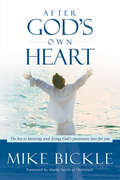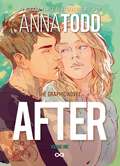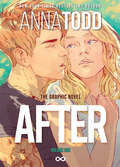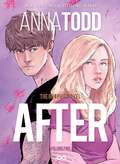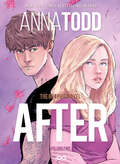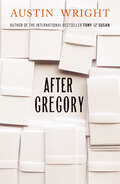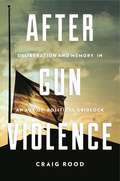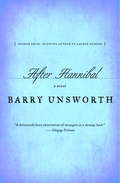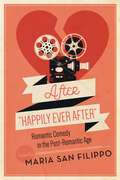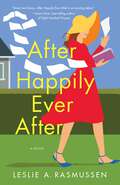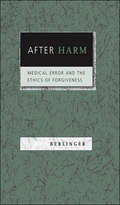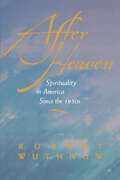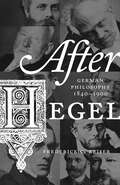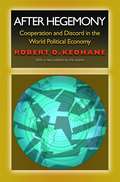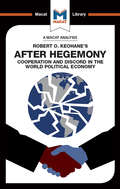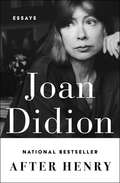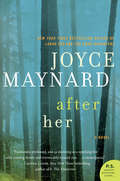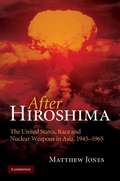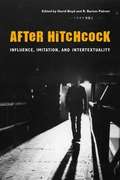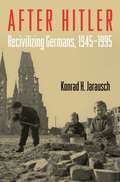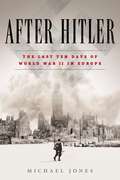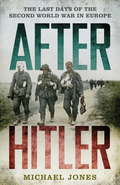- Table View
- List View
After God's Own Heart: The Key to Knowing and Living God's Passionate Love for You
by Mike BickleImagine what David felt like to be singled out and given an almost unfathomable spiritual identity…to seen by God as “a man after His own heart.” David's secret is that he was energized by intimacy with God as a student of God's emotions. He encountered the power of God's emotions. It transformed his emotions for God. You can also become a student of God’s emotions and experience being energized by the Holy Spirit to a life of deep obedience and mature love. Invest time in understanding the emotions found in God’s heart for you, and your own heart will experience a glorious awakening.
AFTER: The Graphic Novel (Volume One)
by Anna ToddFall in love all over again in volume one of the graphic novel adaptation of the global phenomenon AFTER! Uncover Tessa and Hardin's love story as you've never seen it before . . . Anna Todd's original story comes to life with breathtaking illustrations by Pablo Andres. Featuring twelve pages of behind-the-scenes and character profile bonus content, After: The Graphic Novel is a great introduction to the bestselling series for new readers and the ultimate collector's item for fans everywhere!There was the time before Tessa met Hardin, and then there's everything AFTER . . .Tessa is a good girl with a sweet, reliable boyfriend back home. She's got direction, ambition, and a mother determined to keep her on course. But she's barely moved into her freshman dorm when she runs into Hardin Scott, with his tousled brown hair, cocky British accent, and tattoos. Good looking, confident, and rather rude, even a bit cruel. For all his attitude and insults, Tessa should hate Hardin, and she does - until something about his dark mood grabs her, and it's only a matter of time before he ignites a passion in her that she's never known before.He will call her beautiful, then insist he's not the one for her, making excuses and disappearing, again and again. He'll turn away from her, yet when she tries to push him aside, he'll only pull her in deeper. Despite the reckless way Hardin treats her, Tessa is drawn to his vulnerability and determined to unmask the real Hardin beneath all the lies.A good girl . . . a bad boy . . . something undeniable . . . and everything AFTER.
After: The Graphic Novel Volume One
by Anna ToddFall in love all over again in volume one of the graphic novel adaptation of the global phenomenon AFTER!Anna Todd’s original story comes to life with breathtaking illustrations by Pablo Andres. Featuring 12 pages of behind-the-scenes and character profile bonus content, After: The Graphic Novel is a great introduction to the bestselling series for new readers and the ultimate collector’s item for fans everywhere!There was the time before Tessa met Hardin, and then there’s everything AFTER . . .Tessa is a good girl with a sweet, reliable boyfriend back home. She’s got direction, ambition, and a mother determined to keep her on course. But she’s barely moved into her freshman dorm when she runs into Hardin, with his tousled brown hair, cocky British accent, and tattoos. Good looking, confident . . . and rather rude, even a bit cruel. For all his attitude and insults, Tessa should hate Hardin. And she does—until she finds herself alone with him in his room. Something about his dark mood grabs her, and when they kiss it ignites a passion she’s never known before.He'll call her beautiful, then insist he isn’t the one for her, making excuses and disappearing, again and again. He’ll turn away, yet every time when she pushes back, he’ll only pull her in deeper. Despite the reckless way Hardin treats her, Tessa is drawn to his vulnerability, determined to unmask the real Hardin beneath all the lies.A good girl . . . a bad boy . . . something undeniable . . . and everything AFTER.Series note: AFTER: THE GRAPHIC NOVEL (Volume One) will be the first in a multi-title collection that presents the entire AFTER fiction series in graphic novel format. Volume Two is tentatively planned for late 2022/early 2023 and one to two books will be published each year.
AFTER: The Graphic Novel (Volume Two)
by Anna ToddFrom the No. 1 international bestselling author, film producer and Wattpad platform icon Anna Todd - the continuation of her bestselling love story AFTER in Volume Two of After: The Graphic Novel.Fall in love all over again in volume two of the graphic novel adaptation of the global phenomenon AFTER! Uncover Tessa and Hardin's love story as you've never seen it before . . .GOOD INTENTIONS . . . BAD HABITS . . . SOMETHING UNMISTAKABLE . . . AND EVERYTHING AFTER. As Freshman year continues, Tessa and Hardin's chemistry is impossible to ignore. After taking a leap and ending things with her boyfriend from back home, Tessa desperately wants to make something work with Hardin, whose troubled eyes and tattooed arms make her swoon. The magnetism between them is undeniable, and now they have nothing standing in their way.Despite their new freedom, the road is bumpy. The closer they become, the quicker Hardin's walls come up and block Tessa out. But no matter how angry they get at each other, how many times he pushes her too far and she is disappointed by him, they are still drawn to one another. Their romance has consumed them both, and their passion is hot enough to burn everything down.Anna Todd's original story comes to life with breathtaking illustrations by Pablo Andres. Featuring twelve pages of behind-the-scenes and character profile bonus content, Volume Two of After: The Graphic Novel is the ultimate collector's item for fans everywhere!
After: The Graphic Novel Volume Two
by Anna ToddFrom the #1 international bestselling author, film producer and Wattpad platform icon Anna Todd – the continuation of her bestselling love story AFTER in Volume Two of After: The Graphic Novel.As good girl Tessa Young embarks on her first year of college at Washington Central University, she has direction, ambition and a new circle of friends who are always trying to push her beyond her comfort zone. Chief among them is fellow student, campus bad boy – and son of the University’s Chancellor– Hardin Scott, who has simultaneously enraged and seduced her. Tessa can hardly abide Hardin’s antics and ex-girlfriends yet, despite their differences, Tessa and Hardin are undeniably, passionately drawn to one other, and willing to risk a bumpy ride for a romance that will consume and change them both.
After Greenwashing
by Frances BowenBusinesses promote their environmental awareness through green buildings, eco-labels, sustainability reports, industry pledges and clean technologies. When are these symbols wasteful corporate spin, and when do they signal authentic environmental improvements? Based on twenty years of research, three rich case studies, a strong theoretical model and a range of practical applications, this book provides the first systematic analysis of the drivers and consequences of symbolic corporate environmentalism. It addresses the indirect cost of companies' symbolic actions and develops a new concept of the 'social energy penalty' - the cost to society when powerful corporate actors limit the social conversation on environmental problems and their solutions. This thoughtful book develops a set of tools for researchers, regulators and managers to separate useful environmental information from empty corporate spin, and will appeal to researchers and students of corporate responsibility, corporate environmental strategy and sustainable business, as well as environmental practitioners.
After Gregory
by Austin WrightPeter Gregory, a 35-year-old high school English teacher with an ex-wife and kids, tries to drown himself in the Ohio River. Failing to manage even that, he decides to hitch a ride east, fleeing the state and escaping accusations of rape and murder. As he assumes and discards aliases along the way, he believes that he can begin again, a fresh start—but the past has a habit of catching up with all of us, no matter how fast we run.
After Gun Violence: Deliberation and Memory in an Age of Political Gridlock (Rhetoric and Democratic Deliberation #21)
by Craig RoodMass shootings have become the “new normal” in American life. The same can be said for the public debate that follows a shooting: blame is cast, political postures are assumed, but no meaningful policy changes are enacted. In After Gun Violence, Craig Rood argues that this cycle is the result of a communication problem. Without advocating for specific policies, Rood examines how Americans talk about gun violence and suggests how we might discuss the issues more productively and move beyond our current, tragic impasse.Exploring the ways advocacy groups, community leaders, politicians, and everyday citizens talk about gun violence, Rood reveals how the gun debate is about far more than just guns. He details the role of public memory in shaping the discourse, showing how memories of the victims of gun violence, the Second Amendment, and race relations influence how gun policy is discussed. In doing so, Rood argues that forgetting and misremembering this history leads interest groups and public officials to entrenched positions and political failure and drives the public further apart.Timely and innovative, After Gun Violence advances our understanding of public discourse in an age of gridlock by illustrating how public deliberation and public memory shape and misshape one another. It is a search to understand why public discourse fails and how we can do better.
After Gun Violence: Deliberation and Memory in an Age of Political Gridlock (Rhetoric and Democratic Deliberation)
by Craig RoodMass shootings have become the “new normal” in American life. The same can be said for the public debate that follows a shooting: blame is cast, political postures are assumed, but no meaningful policy changes are enacted. In After Gun Violence, Craig Rood argues that this cycle is the result of a communication problem. Without advocating for specific policies, Rood examines how Americans talk about gun violence and suggests how we might discuss the issues more productively and move beyond our current, tragic impasse.Exploring the ways advocacy groups, community leaders, politicians, and everyday citizens talk about gun violence, Rood reveals how the gun debate is about far more than just guns. He details the role of public memory in shaping the discourse, showing how memories of the victims of gun violence, the Second Amendment, and race relations influence how gun policy is discussed. In doing so, Rood argues that forgetting and misremembering this history leads interest groups and public officials to entrenched positions and political failure and drives the public further apart.Timely and innovative, After Gun Violence advances our understanding of public discourse in an age of gridlock by illustrating how public deliberation and public memory shape and misshape one another. It is a search to understand why public discourse fails and how we can do better.
After Hannibal
by Barry UnsworthGolden Umbria is home to breathtaking scenery and great art; it is also where Hannibal and his invading band of Carthaginians ambushed and slaughtered a Roman legion, and where the local place-names still speak of that bloodshed.Unsworth's contemporary invaders include the Greens, a retired American couple seeking serenity among the Umbrian hills, who are bilked out of their savings by the corrupt English "building expert" Stan Blemish; the Chapmans, a British property speculator and his wife, whose dispute with their neighbors over a wall escalates into a feud of nearly medieval proportions; Anders Ritter, a German haunted by the part his father played in a mass killing of Italian hostages in Rome during the Second World War; and Fabio and Arturo, a gay couple who, searching for peace and self-sufficiency, find treachery instead. And at the center of all these webs of deceit and greed is the cunning lawyer Mancini, happy to aid the disputants--and to exploit to the fullest the faith that these "innocents abroad" have placed in him.
After "Happily Ever After": Romantic Comedy in the Post-Romantic Age (Contemporary Approaches to Film and Media Series)
by Maria San Filippo Deborah Jermyn Martha Shearer John Alberti James MacDowell Tom Cunliffe Beatriz Oria Betty Kaklamanidou Mary Harrod Maya Montañez Smukler Elizabeth Alsop Alice Guilluy Ash Kinney D'Harcourt Tamar Jeffers MacDonald Sueyoung Park-Primiano Manuela RuizIn defiance of the alleged "death of romantic comedy," After "Happily Ever After": Romantic Comedy in the Post-Romantic Age edited by Maria San Filippo attests to rom-com’s continuing vitality in new modes and forms that reimagine and rejuvenate the genre in ideologically, artistically, and commercially innovative ways. No longer the idyllic fairy tale, today’s romantic comedies ponder the realities and complexities of intimacy, fortifying the genre’s gift for imagining human connection through love and laughter. It has often been observed that the rom-com’s "happily ever after" trope enables the genre to avoid addressing the challenges of coupled life. This volume’s contributors confront how recent rom-coms contend with a "post-romantic age" of romantic disillusionment and seismically shifting emotional and relational bonds. Fifteen chapters contemplate the resurgence of the "radical romantic comedy" and uncoupling comedy, new approaches in genre hybridity and serial narrative, and how recent rom-coms deal with divisive topical issues and contemporary sexual mores from reproductive politics and marriage equality to hook-up culture and technology-enabled sex. Rom-coms remain underappreciated and underexamined—and still largely defined within Hollywood’s parameters of culturally normative coupling and its persistent marginalization of racial and sexual minorities. Making the case for taking romantic comedy seriously, this volume employs critical perspectives drawn from feminist, queer, postcolonial, and race studies to critique the genre’s homogeneity and social and sexual conservatism, recognizing innovative works inclusive of LGBTQ people, people of color, and the differently aged and abled. Encompassing a rich range of screen media from the last decade, After "Happily Ever After" celebrates works that disrupt and subvert rom-com fantasy and formula so as to open audience’s eyes along with our hearts. This volume is intended for all readers with an interest in film, media, and gender studies.
After Happily Ever After: A Novel
by Leslie A. Rasmussen“Smart and funny, After Happily Ever After is an exciting debut.” —Laura Dave, international best-selling author of The Last Thing He Told MeWhat if you had the chance to relinquish the life you’ve built and begin again?At the age of forty-five, Maggie Dolin is grappling with the realities of aging. Nearly two decades ago, she made the decision to leave her career in publishing to devote herself to raising her daughter, Gia—but now that Gia is about to leave for college, Maggie is confronted with uncertainty about her own identity and purpose. Having spent so many years caring for others, she struggles to remember the last time someone cared for her.Meanwhile, Maggie’s husband of nineteen years, Jim, seems distant and preoccupied, leading her to suspect that he is keeping secrets from her; her mother is self-absorbed and judgmental; and her brother harbors resentment toward her. And to compound matters, the one constant in Maggie's life, her father, is facing serious health challenges, leaving her feeling adrift without his unwavering support.As Maggie embarks on a daunting journey of self-discovery, she finds herself drawn toward decisions that challenge the life she has always known. After Happily Ever After deals with love, marriage, family dynamics, the empty nest, aging parents, and what happens when they all come crashing down at the same time.
After Harm: Medical Error and the Ethics of Forgiveness
by Nancy BerlingerMedical error is a leading problem of health care in the United States. Each year, more patients die as a result of medical mistakes than are killed by motor vehicle accidents, breast cancer, or AIDS. While most government and regulatory efforts are directed toward reducing and preventing errors, the actions that should follow the injury or death of a patient are still hotly debated. According to Nancy Berlinger, conversations on patient safety are missing several important components: religious voices, traditions, and models. In After Harm, Berlinger draws on sources in theology, ethics, religion, and culture to create a practical and comprehensive approach to addressing the needs of patients, families, and clinicians affected by medical error. She emphasizes the importance of acknowledging fallibility, telling the truth, confronting feelings of guilt and shame, and providing just compensation. After Harm adds important human dimensions to an issue that has profound consequences for patients and health care providers.
After Heaven: Spirituality in America Since the 1950s
by Robert WuthnowThe evolution of American spirituality over the past fifty years is the subject of Robert Wuthnow's engrossing new book. Wuthnow uses in-depth interviews and a broad range of resource materials to show how Americans, from teenagers to senior citizens, define their spiritual journeys. His findings are a telling reflection of the changes in beliefs and lifestyles that have occurred throughout the United States in recent decades.Wuthnow reconstructs the social and cultural reasons for an emphasis on a spirituality of dwelling (houses of worship, denominations, neighborhoods) during the 1950s. Then in the 1960s a spirituality of seeking began to emerge, leading individuals to go beyond established religious institutions. In subsequent chapters Wuthnow examines attempts to reassert spiritual discipline, encounters with the sacred (such as angels and near-death experiences), and the development of the "inner self." His final chapter discusses a spirituality of practice, an alternative for people who are uncomfortable within a single religious community and who want more than a spirituality of endless seeking.The diversity of contemporary American spirituality comes through in the voices of the interviewees. Christians, Jews, Buddhists, Muslims, Hindus, and Native Americans are included, as are followers of occult practices, New Age religions, and other eclectic groups. Wuthnow also notes how politicized spirituality, evangelical movements, and resources such as Twelve-Step programs and mental health therapy influence definitions of religious life today.Wuthnow's landmark book, The Restructuring of American Religion (1988), documented the changes in institutional religion in the United States; now After Heaven explains the changes in personal spirituality that have come to shape our religious life. Moreover, it is a compelling and insightful guide to understanding American culture at century's end.
After Hegel: German Philosophy, 1840–1900
by Frederick C. BeiserHistories of German philosophy in the nineteenth century typically focus on its first half—when Hegel, idealism, and Romanticism dominated. By contrast, the remainder of the century, after Hegel's death, has been relatively neglected because it has been seen as a period of stagnation and decline. But Frederick Beiser argues that the second half of the century was in fact one of the most revolutionary periods in modern philosophy because the nature of philosophy itself was up for grabs and the very absence of certainty led to creativity and the start of a new era. In this innovative concise history of German philosophy from 1840 to 1900, Beiser focuses not on themes or individual thinkers but rather on the period’s five great debates: the identity crisis of philosophy, the materialism controversy, the methods and limits of history, the pessimism controversy, and the Ignorabimusstreit. Schopenhauer and Wilhelm Dilthey play important roles in these controversies but so do many neglected figures, including Ludwig Büchner, Eugen Dühring, Eduard von Hartmann, Julius Fraunstaedt, Hermann Lotze, Adolf Trendelenburg, and two women, Agnes Taubert and Olga Pluemacher, who have been completely forgotten in histories of philosophy. The result is a wide-ranging, original, and surprising new account of German philosophy in the critical period between Hegel and the twentieth century.
After Hegemony: Cooperation and Discord in the World Political Economy
by Robert O. KeohaneThis book is a comprehensive study of cooperation among the advanced capitalist countries. Can cooperation persist without the dominance of a single power, such as the United States after World War II? To answer this pressing question, Robert Keohane analyzes the institutions, or "international regimes," through which cooperation has taken place in the world political economy and describes the evolution of these regimes as American hegemony has eroded. Refuting the idea that the decline of hegemony makes cooperation impossible, he views international regimes not as weak substitutes for world government but as devices for facilitating decentralized cooperation among egoistic actors. In the preface the author addresses the issue of cooperation after the end of the Soviet empire and with the renewed dominance of the United States, in security matters, as well as recent scholarship on cooperation.
After Hegemony
by Ramon Pacheco PardoRobert O. Keohane’s After Hegemony is both a classic of international relations scholarship and an example of how creative thinking can help shed new light on the world. Since the end of World War II, the global political landscape had been dominated by two superpowers, the USA and the USSR, and the tense stand-off of the Cold War. But, as the Cold War began to thaw, it became clear that a new global model might emerge. The commonly held belief amongst those studying international relations was that it was impossible for nations to work together without the influence of a hegemon (a dominant international power) to act as both referee and ultimate decision-maker. This paradigm – neorealism – worked on the basis that every nation will do all it can to maximize its power, with such processes only checked by a balance of competing powers. Keohane, however, examined the evidence afresh and came up with novel explanations for what was likely to come next. He went outside the dominant paradigm, and argued for what came to be known as the neoliberal conception of international politics. States, Keohane said, can and will cooperate without the influence of a hegemonic power, so long as doing so brings them absolute gains in the shape of economic and cultural benefits. In Keohane’s highly-creative view, the pursuit of national self-interest leads naturally to international cooperation – and to the formation of global regimes (such as the United Nations) that can reinforce and foster it.
After Henry: Essays
by Joan DidionIncisive essays on Patty Hearst and Reagan, the Central Park jogger and the Santa Ana winds, from the New York Times–bestselling author of South and West. In these eleven essays covering the national scene from Washington, DC; California; and New York, the acclaimed author of Slouching Towards Bethlehem and The White Album &“capture[s] the mood of America&” and confirms her reputation as one of our sharpest and most trustworthy cultural observers (The New York Times). Whether dissecting the 1988 presidential campaign, exploring the commercialization of a Hollywood murder, or reporting on the &“sideshows&” of foreign wars, Joan Didion proves that she is one of the premier essayists of the twentieth century, &“an articulate witness to the most stubborn and intractable truths of our time&” (Joyce Carol Oates, The New York Times Book Review). Highlights include &“In the Realm of the Fisher King,&” a portrait of the White House under the stewardship of Ronald and Nancy Reagan, two &“actors on location;&” and &“Girl of the Golden West,&” a meditation on the Patty Hearst case that draws an unexpected and insightful parallel between the kidnapped heiress and the emigrants who settled California. &“Sentimental Journeys&” is a deeply felt study of New York media coverage of the brutal rape of a white investment banker in Central Park, a notorious crime that exposed the city&’s racial and class fault lines. Dedicated to Henry Robbins, Didion&’s friend and editor from 1966 until his death in 1979, After Henry is an indispensable collection of &“superior reporting and criticism&” from a writer on whom we have relied for more than fifty years &“to get the story straight&” (Los Angeles Times).
After Her
by Joyce MaynardThe New York Times bestselling author of Labor Day and The Good Daughters returns with a haunting novel of sisterhood, sacrifice, and suspense. I was always looking for excitement, until I found some . . . Summer, 1979. A dry, hot Northern California school vacation stretches before Rachel and her younger sister, Patty--the daughters of a larger-than-life, irresistibly handsome (and chronically unfaithful) detective father and the mother whose heart he broke. When we first meet her, Patty is eleven--a gangly kid who loves basketball and dogs and would do anything for her older sister, Rachel. Rachel is obsessed with making up stories and believes she possesses the gift of knowing whats in the minds of people around her. She has visions, whether she wants to or not. Left to their own devices, the sisters spend their days studying record jackets, concocting elaborate fantasies about the mysterious neighbor who moved in down the street, and playing dangerous games on the mountain that looms behind their house. When young women start turning up dead on the mountain, the girls father is put in charge of finding the murderer known as the "Sunset Strangler. " Watching her fathers life slowly unravel as months pass and more women are killed, Rachel embarks on her most dangerous game yet . . . using herself as bait to catch the killer. But rather than cracking the case, the consequences of Rachels actions will destroy her fathers career and alter forever the lives of everyone she loves. Thirty years later, still haunted by the belief that the killer remains at large, Rachel constructs a new strategy to smoke out the Sunset Strangler and vindicate her father--a plan that unexpectedly unearths a long-buried family secret. Loosely inspired by the Trailside Killer case that terrorized Marin County, California, in the late 1970s, After Her is part thriller, part love story. Maynard has created a poignant, suspenseful, and painfully real family saga that traces a young girls first explorations of sexuality, the loss of innocence, the bond shared by sisters, and the tender but damaged relationship between a girl and her father that endures even beyond the grave.
After Hiroshima
by Matthew JonesBy emphasising the role of nuclear issues, After Hiroshima provides a new history of American policy in Asia between the dropping of the atomic bombs on Japan and the escalation of the Vietnam War. Drawing on a wide range of documentary evidence, Matthew Jones charts the development of American nuclear strategy and the foreign policy problems it raised, as the United States both confronted China and attempted to win the friendship of an Asia emerging from colonial domination. In underlining American perceptions that Asian peoples saw the possible repeat use of nuclear weapons as a manifestation of Western attitudes of 'white superiority', he offers new insights into the links between racial sensitivities and the conduct of US policy, and a fresh interpretation of the transition in American strategy from massive retaliation to flexible response in the era spanned by the Korean and Vietnam Wars.
After Hitchcock: Influence, Imitation, and Intertextuality
by David Boyd Palmer R. BartonAlfred Hitchcock is arguably the most famous director to have ever made a film. Almost single-handedly he turned the suspense thriller into one of the most popular film genres of all time, while his Psycho updated the horror film and inspired two generations of directors to imitate and adapt this most Hitchcockian of movies. Yet while much scholarly and popular attention has focused on the director's oeuvre, until now there has been no extensive study of how Alfred Hitchcock's films and methods have affected and transformed the history of the film medium. In this book, thirteen original essays by leading film scholars reveal the richness and variety of Alfred Hitchcock's legacy as they trace his shaping influence on particular films, filmmakers, genres, and even on film criticism. Some essays concentrate on films that imitate Hitchcock in diverse ways, including the movies of Brian de Palma and thrillers such as True Lies, The Silence of the Lambs, and Dead Again. Other essays look at genres that have been influenced by Hitchcock's work, including the 1970s paranoid thriller, the Italian giallo film, and the post-Psycho horror film. The remaining essays investigate developments within film culture and academic film study, including the enthusiasm of French New Wave filmmakers for Hitchcock's work, his influence on the filmic representation of violence in the post-studio Hollywood era, and the ways in which his films have become central texts for film theorists.
After Hitler: Recivilizing Germans, 1945-1995
by Konrad H. Jarausch Konrad HunzikerIn the spring of 1945, as the German army fell in defeat and the world first learned of the unspeakable crimes of the Holocaust, few would have expected that, only half a century later, the Germans would emerge as a prosperous people at the forefront of peaceful European integration. How did the Germans manage to recover from the shattering experience of defeat in World War II and rehabilitate themselves from the shame and horror of the Holocaust? In After Hitler, Konrad H. Jarausch shows how Germany's determination to emphasize civility and civil society, destroyed by the Nazi regime,helped restore the demoralized nation during the post-war period. Unlike other intellectual inquiries into German efforts to deal with the Nazi past, After Hitler primarily focuses on the practical lessons a disoriented people drew from their past misdeeds, and their struggle to create a new society with a sincere and deep commitment to human rights. After Hitler offers a comprehensive view of the breathtaking transformation of the Germans from the defeated Nazi accomplices and Holocaust perpetrators of 1945 to the civilized, democratic people of today's Germany.
After Hitler
by Michael JonesFrom the acclaimed author of The King's Mother and Bosworth 1485--a fascinating look at ten days that changed the course of history...With the world at war, ten days can feel like a lifetime.... On April 30, 1945, Adolf Hitler committed suicide in a bunker in Berlin. But victory over the Nazi regime was not celebrated in western Europe until May 8, and in Russia a day later, on the ninth. Why did a peace agreement take so much time? How did this brutal, protracted conflict coalesce into its unlikely endgame? After Hitler shines a light on ten fascinating days after that infamous suicide that changed the course of the twentieth century. Combining exhaustive research with masterfully paced storytelling, Michael Jones recounts the Führer's frantic last stand; the devious maneuverings of his handpicked successor, Karl Dönitz; the grudging respect Joseph Stalin had for Churchill and FDR, as well as his distrust of Harry Truman; the bold negotiating by General Dwight D. Eisenhower that hastened Germany's surrender but drew the ire of the Kremlin; the journalist who almost scuttled the cease-fire; and the thousands of ordinary British, American, and Russian soldiers caught in the swells of history, from the Red Army's march on Berlin to the liberation of the Nazis' remaining concentration camps. Through it all, Jones traces the shifting loyalties between East and West that sowed the seeds of the Cold War and nearly unraveled the Grand Alliance. In this gripping, eloquent, and even-handed narrative, the spring of 1945 comes alive--a fascinating time when nothing was certain, and every second mattered....INCLUDES PHOTOSFrom the Hardcover edition.
After Hitler: The Last Days of the Second World War in Europe
by Michael JonesOn 30 April 1945, Adolf Hitler committed suicide. The following day, his propaganda minister Joseph Goebbels also killed himself and the crumbling Third Reich passed to Admiral Karl Dönitz. The Nazis' position seemed hopeless. Yet remarkably, the war in the rest of Europe went on for another ten days. After Hitler looks at these days as a narrative day-by-day countdown but also as a broader global history of a European war that had seen some of the most savage battles in history. Relations between the 'Big Three' - the United States, Great Britain and the Soviet Union - suddenly plunged to near breaking point. This book reveals that tumultuous story.After Hitler also looks at the wider canvas of the war and the terrible humanitarian catastrophe uncovered in Europe. It describes those who felt the joy of freedom, but also those who faced a highly uncertain future. As Red Army soldiers joined forces with their British and American allies, Stalin's East finally came face to face with Churchill's and Truman's West. After Hitler tells of their growing mistrust, but also of moments of remarkable goodwill and co-operation - the brief but poignant hope that these great nations could together fashion a new and safer future. This is a fascinating exploration of the brief but crucial period that shaped the emerging post-war world.
